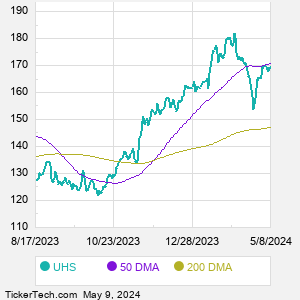Universal Health Services is a holding company. Co.'s principal business is owning and operating, through its subsidiaries, acute care hospitals and outpatient facilities and behavioral health care facilities. Services provided by Co.'s hospitals include general and specialty surgery, internal medicine, obstetrics, emergency room care, radiology, oncology, diagnostic care, coronary care, pediatric services, pharmacy services and/or behavioral health services. Co. provides capital resources as well as a variety of management services to its facilities, including central purchasing, information services, finance and control systems, facilities planning and physician recruitment services.
When researching a stock like Universal Health Services, many investors are the most familiar with Fundamental Analysis — looking at a company's balance sheet, earnings, revenues, and what's happening in that company's underlying business. Investors who use Fundamental Analysis to identify good stocks to buy or sell can also benefit from UHS Technical Analysis to help find a good entry or exit point. Technical Analysis is blind to the fundamentals and looks only at the trading data for UHS stock — the real life supply and demand for the stock over time — and examines that data in different ways. One of those ways is to calculate a Simpe Moving Average ("SMA") by looking back a certain number of days. One of the most popular "longer look-backs" is the UHS 200 day moving average ("UHS 200 DMA"), while one of the most popular "shorter look-backs" is the UHS 50 day moving average ("UHS 50 DMA"). A chart showing both of these popular moving averages is shown on this page for Universal Health Services. Comparing two moving averages against each other can be a useful visualization tool: by calculating the difference between the UHS 200 DMA and the UHS 50 DMA, we get a moving average convergence divergence indicator ("UHS MACD"). The UHS MACD chart, in conjunction with the chart of the moving averages, basically helps in visualizing how the moving averages are showing convergence (moving closer together), or divergence (moving farther apart). |



